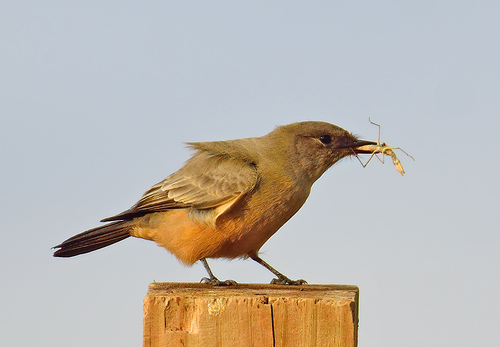
Say's Phoebe
The Say's Phoebe (Sayornis saya) is a medium-sized, insectivorous passerine bird native to western North America. It is known for its preference for open, arid habitats and its habit of perching conspicuously on fences, wires, and low branches, often pumping its tail. Named after the American naturalist Thomas Say, this bird plays a crucial role in controlling insect populations within its range. It is not considered globally threatened, but localized habitat loss can affect populations.
16-20 cm
Length
30-34 cm
Wingspan
Least Concern
Conservation Status
Distribution
Western North America, from Alaska and northwestern Canada south through the western United States to central Mexico. Northern populations are migratory, wintering in the southern part of the range and into Mexico. They have a broad altitudinal range, from sea level to over 3,000 meters.
Lifespan
Up to 10 years in the wild has been recorded, but the average lifespan is likely shorter.
Say's Phoebe's Habitat
Habitat Types
Dry grasslands, Shrublands, Open woodlands, Agricultural areas, Canyons, Cliffs
Climate Zones
Temperate, Arid, Semi-arid
Adaptations
Tolerant of dry conditions and open habitats with sparse vegetation. Often nests near human structures, utilizing eaves, bridges, and outbuildings.
Variations
There are generally considered to be two subspecies: *Sayornis saya saya* (the more widespread northern subspecies) and *Sayornis saya quiescens* (found in Baja California).
Appearance
Breeding Plumage
Little difference between breeding and non-breeding plumage.
Seasonal Feather Changes
Minimal seasonal variation.
Sex Based Plumage Differences
Males and females have similar plumage: grayish-brown upperparts, a paler gray breast, and a cinnamon-rufous belly and undertail coverts. The head is typically a darker gray than the back.
Notable Features
Cinnamon-rufous belly, Dark gray head, Tail-pumping behavior
Diet and Feeding
Primary Foods
Insects, Spiders, Other small arthropods
Foraging Behavior
Typically hunts by perching on a low vantage point and sallying out to catch flying insects in mid-air (hawking). Also gleans insects from foliage or the ground. Will occasionally hover to capture prey.
Specializations
Excellent aerial agility for catching insects on the wing.
Seasonal Diet Variations
Diet consists almost entirely of insects during the breeding season. May consume small amounts of berries and seeds, especially during winter when insects are less abundant.
Behavior
Social Structure
Generally solitary or found in pairs during the breeding season. May form small, loose flocks during migration and in winter.
Communication
A plaintive, whistled *phee-eur* call, A rapid series of *pit-pit-pit* notes, Wing and tail movements during displays
Migration
Northern populations are migratory, with some individuals traveling long distances between breeding and wintering grounds. Southern populations may be resident or only make short-distance movements.
Territorial or Group Behaviors
Territorial during the breeding season, defending nesting sites and foraging areas from other Say's Phoebes and sometimes other species.
Conservation
Threats
Habitat loss (due to agriculture, urbanization, and overgrazing), Pesticide use (reducing insect prey availability), Climate change (potentially altering habitat and insect emergence times)
Protection Programs
General protections under the Migratory Bird Treaty Act in the US and Canada, Some habitat conservation efforts within protected areas
Local National Laws
Protected under the Migratory Bird Treaty Act in the United States.
Population Trend
Stable
Population Estimates
The global population is estimated to be around 5.5 million individuals.
Interesting Facts
They often reuse nests from previous years.
This can save time and energy during the breeding season. They may add new material to an existing nest.
Say's Phoebes are known for their early arrival on breeding grounds.
They are among the first migrants to return to northern breeding areas in spring.
They can tolerate relatively cold temperatures.
This allows them to breed in higher elevations and latitudes than many other flycatchers.
Faqs about Say's Phoebe
What do Say's Phoebes eat?
They primarily eat insects, which they catch in flight or glean from the ground or vegetation.
Where do Say's Phoebes build their nests?
They build cup-shaped nests in sheltered locations, such as under eaves, on cliffs, in culverts, or on bridges.
Are Say's Phoebes endangered?
No, they are currently classified as Least Concern by the IUCN, meaning they are not considered to be globally threatened.
How can I attract Say's Phoebes to my yard?
Provide open areas with perches, avoid using pesticides, and consider providing a nesting shelf if you have a suitable structure.
Copyright @ Nature Style Limited. All Rights Reserved.
 English
English